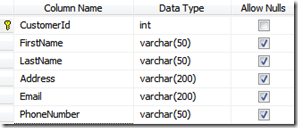FOR XML Path ( SQL Server )
For xml path gives you flexibility to generate xml from your database in the desired structure with less code .
Believe me once you learn the xml path you will love this feature .
So lets start with a simple customer table , the schema of the table is as follows :
If if just write for xml auto query like this :
select * from dbo.Customer for xml auto
, we will get the xml like this :
<dbo.Customer CustomerId="1" FirstName="Priyanka" LastName="Srivastava" Address="lucknow" Email="priyanka@yahoo.com" PhoneNumber="23232232" />
<dbo.Customer CustomerId="2" FirstName="Manish " LastName="Sharma" Address="mumbai" Email="manish@gmail.com" PhoneNumber="232323" />
<dbo.Customer CustomerId="3" FirstName="Kanak" LastName="Srivastava" Address="Delhi" Email="kanak@hotmail.com" PhoneNumber="2165273" />
<dbo.Customer CustomerId="4" FirstName="Rachita" LastName="Pandey" Address="Bhopal" Email="Rachita@abc.com" PhoneNumber="7868768" />
<dbo.Customer CustomerId="5" FirstName="Jitender" LastName="Singh" Address="Patiala" Email="Jitender@abc.com" PhoneNumber="897879" />
Now if you want your xml to be structured in very customized way , we can use for xml path . in this we have option to choose whether we want to show a particular column as an attribute or an element .
To display a column as an attribute add <‘@’> before alias name and to make an element just write the alias name .suppose you want to get every customer record with a Customer tag and first name with FisrtName attribute and last name with LastName Attribute.
SELECT CustomerId AS '@Id',
FirstName AS '@FirstName',
LastName AS '@LastName'
FROM dbo.Customer FOR XML PATH('Customer')
Resultant XML will be :
<Customer Id="1" FirstName="Priyanka" LastName="Srivastava" />
<Customer Id="2" FirstName="Manish " LastName="Sharma" />
<Customer Id="3" FirstName="Kanak" LastName="Srivastava" />
<Customer Id="4" FirstName="Rachita" LastName="Pandey" />
<Customer Id="5" FirstName="Jitender" LastName="Singh" />
We can do any kind of manipulation in the select phrase and give it as an attribute of element of the xml :
SELECT CustomerId AS '@Id',
FirstName + ' ' + LastName AS '@Name'
FROM dbo.Customer FOR XML PATH('Customer')
Resultant XML will be :
<Customer Id="1" Name="Priyanka Srivastava" />
<Customer Id="2" Name="Manish Sharma" />
<Customer Id="3" Name="Kanak Srivastava" />
<Customer Id="4" Name="Rachita Pandey" />
<Customer Id="5" Name="Jitender Singh" />
To provide a root element of the table rows we need to use ROOT keyword
SELECT CustomerId AS '@Id',
FirstName + ' ' + LastName AS '@Name'
FROM dbo.Customer FOR XML PATH('Customer'), ROOT ('MyCustomers')
Resultant XML will be :
<MyCustomers>
<Customer Id="1" Name="Priyanka Srivastava" />
<Customer Id="2" Name="Manish Sharma" />
<Customer Id="3" Name="Kanak Srivastava" />
<Customer Id="4" Name="Rachita Pandey" />
<Customer Id="5" Name="Jitender Singh" />
</MyCustomers>
Now suppose we need the Contact details as child element in the customer element , and within the Contact details we need three different attributes for address , email and phone number :
SELECT CustomerId AS '@Id',
FirstName + ' ' + LastName AS '@Name',
[Address] AS 'ContactDetails/@PostalAddress',
Email AS 'ContactDetails/@EmailAddress',
PhoneNumber AS 'ContactDetails/@PhoneNumber'
FROM dbo.Customer FOR XML PATH('Customer'), ROOT ('MyCustomers')
Resultant XML will be :
<MyCustomers>
<Customer Id="1" Name="Priyanka Srivastava">
<ContactDetails PostalAddress="lucknow" EmailAddress="priyanka@yahoo.com" PhoneNumber="23232232" />
</Customer>
<Customer Id="2" Name="Manish Sharma">
<ContactDetails PostalAddress="mumbai" EmailAddress="manish@gmail.com" PhoneNumber="232323" />
</Customer>
<Customer Id="3" Name="Kanak Srivastava">
<ContactDetails PostalAddress="Delhi" EmailAddress="kanak@hotmail.com" PhoneNumber="2165273" />
</Customer>
<Customer Id="4" Name="Rachita Pandey">
<ContactDetails PostalAddress="Bhopal" EmailAddress="Rachita@abc.com" PhoneNumber="7868768" />
</Customer>
<Customer Id="5" Name="Jitender Singh">
<ContactDetails PostalAddress="Patiala" EmailAddress="Jitender@abc.com" PhoneNumber="897879" />
</Customer>
</MyCustomers>
Now if we want the address , phone and email should be elements within the customer tag :
SELECT CustomerId AS '@Id',
FirstName + ' ' + LastName AS '@Name',
[Address] AS 'ContactDetails/PostalAddress',
Email AS 'ContactDetails/EmailAddress',
PhoneNumber AS 'ContactDetails/PhoneNumber'
FROM dbo.Customer FOR XML PATH('Customer'), ROOT ('MyCustomers')
Resultant XML will be :
<MyCustomers>
<Customer Id="1" Name="Priyanka Srivastava">
<ContactDetails>
<PostalAddress>lucknow</PostalAddress>
<EmailAddress>priyanka@yahoo.com</EmailAddress>
<PhoneNumber>23232232</PhoneNumber>
</ContactDetails>
</Customer>
<Customer Id="2" Name="Manish Sharma">
<ContactDetails>
<PostalAddress>mumbai</PostalAddress>
<EmailAddress>manish@gmail.com</EmailAddress>
<PhoneNumber>232323</PhoneNumber>
</ContactDetails>
</Customer>
<Customer Id="3" Name="Kanak Srivastava">
<ContactDetails>
<PostalAddress>Delhi</PostalAddress>
<EmailAddress>kanak@hotmail.com</EmailAddress>
<PhoneNumber>2165273</PhoneNumber>
</ContactDetails>
</Customer>
<Customer Id="4" Name="Rachita Pandey">
<ContactDetails>
<PostalAddress>Bhopal</PostalAddress>
<EmailAddress>Rachita@abc.com</EmailAddress>
<PhoneNumber>7868768</PhoneNumber>
</ContactDetails>
</Customer>
<Customer Id="5" Name="Jitender Singh">
<ContactDetails>
<PostalAddress>Patiala</PostalAddress>
<EmailAddress>Jitender@abc.com</EmailAddress>
<PhoneNumber>897879</PhoneNumber>
</ContactDetails>
</Customer>
</MyCustomers>
Joining multiple tables also work in same way u just need to understand the XML structure and apply elements or tags within the select clause .
Hope this will be helpful to start with the XML path . Actually you can do much more than this using this powerful SQL Feature :)
Let me know if you are facing any issue in implementing this in comment section of this blog .
Cheers
Priyanka

